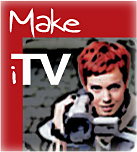The prototype was built from an ordinary webcam and a battery-powered 3M projector, with an attached mirror -- all connected to an internet-enabled mobile phone. The setup, which costs less than $350, allows the user to project information from the phone onto any surface -- walls, the body of another person or even your hand.
Pranav Mistry, "the brains behind the project," wears the device on a lanyard around his neck. Colored Magic Marker caps on four fingers (red, blue, green and yellow) help the camera distinguish the four fingers and recognize his hand gestures with software that Mistry created.
The gestures can be as simple as using his fingers and thumbs to create a picture frame that tells the camera to snap a photo, which is saved to his mobile phone. When he gets back to an office, he projects the images onto a wall and begins to size them.
When he encounters someone at a party, the system projects a cloud of words on the person's body to provide more information about him -- his blog URL, the name of his company, his likes, interests, and who knows what else....
When Mistry folds his hands in "namaste" fashion, the system opens a menu to allow him to choose an application. If he wants to read e-mail on his phone, he draws an @ symbol in the air with his finger. He can project a phone pad onto his palm and dial a number without removing the phone from his pocket. As he reads the newspaper on the subway he can project a video onto the page that provides more information about the topic he's reading.
Maes, Mistry's instructor, and Mistry have been working on the project for four months, day and night, and have filed a patent for it.
Maes' MIT group, which includes seven graduate students, were thinking about how a person could be more integrated into the world around them and access information without having to do something like take out a phone. They initially produced a wristband that would read an RFID tag to know, for example, which book a user is holding in a store.
They also had a ring that used infrared to communicate by beacon to supermarket smart shelves to give you information about products. As you grab a package of macaroni, the ring would glow red or green to tell you if the product was organic or free of peanut traces -- whatever criteria you program into the system.
"We wanted to make information more useful to people in real time with minimal effort in a way that doesn't require any behavior changes," Maes said. "The wristband was getting close, but you still had to take out your cell phone to look at the information."
That's when they struck on the idea of accessing information from the internet and projecting it. So someone wearing the wristband could pick up a paperback in the bookstore and immediately call up reviews about the book, projecting them onto a surface in the store or doing a keyword search through the book by accessing digitized pages on Amazon or Google books.
They started with a larger projector that was mounted on a helmet. But that proved cumbersome if someone was projecting data onto a wall then turned to speak to friend -- the data would project on the friend's face. Last month, they switched to a smaller projector and created the pendant prototype to be worn around the neck.
This year's TED demo was the first time they've shown it in public, though they're far from making a commercial product or forming a company around their invention. "But we're really excited about the potential," Maes said.
They learned recently that cellphone makers soon plan to release cellphones with projectors integrated in them, which will simplify their system even more.
Cybercast credit: Brightcove




No comments:
Post a Comment